1. Background of Mantle
1.1 Project Introduction
Overview
The public chain track has always been the main battlefield of Web3. Since the birth of Ethereum, there have been many challengers. On the basis of Ethereum, the L2 route dispute has been derived, until today's L2 era of a hundred schools of thought. We can gradually see that technological innovation and high performance alone are not enough. A public chain is like a digital kingdom. It needs a sufficiently prosperous ecosystem and the consensus of a large number of developers and users to continuously obtain "taxes".
Mantle is a dark horse that has broken through the siege in this fiercely competitive track. Since the launch of the mainnet in July 2023, in just over a year, it has become the fourth-ranked L2 in TVL, and has an extremely large treasury support of 2.6 billion US dollars. It has become the top L2 and has the momentum to become a first-tier public chain. So, how did Mantle get to where it is today step by step, and what greater development will it have in the future? We will conduct a more in-depth discussion in this article.
Important Development Nodes
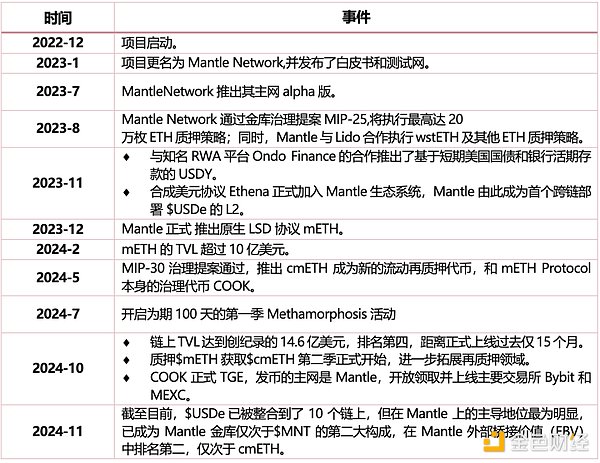
1.2 Token Economics
$MNT tokens are governance tokens and utility tokens in the Mantle ecosystem, with a total of 6.219 billion. As a governance token, each $MNT has voting rights in the Mantle governance process. As a utility token, $MNT can be used to pay for gas fees on the Mantle network and is also the main asset for Mantle rewards. This is actually a big difference between Mantle and other L2s. It consumes $MNT as gas fees, which is conducive to the increase in the value of $MNT.
According to the official $MNT initial allocation snapshot provided on 2023-07-07, the distribution of $MNT is as follows:
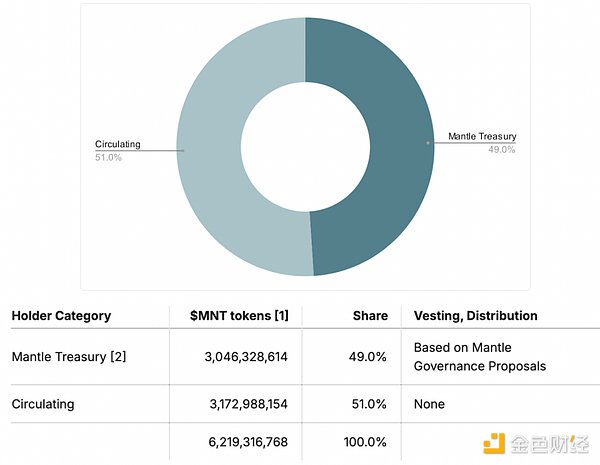
Source: Mantle
From the distribution chart, it can be seen that Mantle Treasury holds nearly half of the $MNT tokens, which are "non-circulating". The distribution of Mantle Treasury's $MNT tokens is subject to the Mantle governance process, and the budget, fund raising and allocation process follows strict procedures. After the initial distribution, the sources of $MNT in the Mantle Treasury include: irregular contributions from third parties and Mantle's mainnet gas fee income.
The Mantle core budget is the main expenditure of $MNT, which is used for the following payments and rewards: labor, general and administrative expenses, marketing, ecosystem and builder programs, and infrastructure and security.
In MIP-31, which was just passed in September 2024, Mantle made a new plan for its second budget cycle (the 12-month period from July 2024 to June 2025), among which the main expenditures are: R&D and growth (15 million $USDx and 20 million $MNT), marketing (12 million $USDx and 20 million $MNT). In fact, Mantle has worked with various marketing agencies and research entities, including Bankless, Unchained Podcast, Delphi Digital, Messari, and other well-known media and research institutions and influential thought leaders have reported on Mantle.
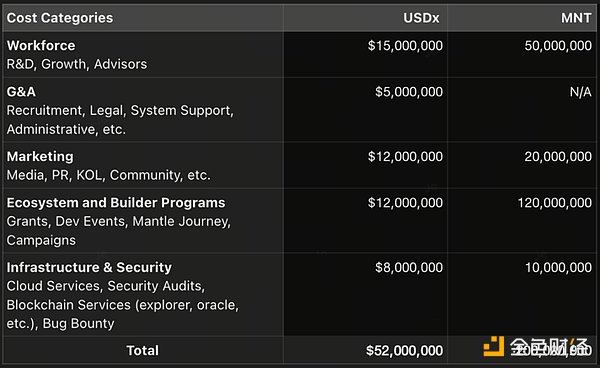
Mantle's budget composition, source: Mantle
1.3 Data Overview
Project Related Data
Let's now compare multiple sets of data to establish a specific perception of Mantle's growth over the past year. We know that Mantle will be launched on the mainnet on July 17, 2023. It can be seen that after a period of stability, there will be explosive growth in early 2024.
In terms of TVL, Mantle's on-chain TVL just exceeded US$400 million in early February this year, and then began to advance rapidly, reaching a peak of nearly US$1.5 billion in April 2024, an increase of more than 300% in 4 months. As of the time of writing, Mantle's latest on-chain TVL data is US$1.38 billion, ranking fourth in L2. As a basic indicator for evaluating the development of L2, TVL largely reflects the value information of user participation, market confidence and the health of the ecosystem. The rapidly growing TVL often represents the trust and acceptance of users, and is also one of the proofs that Mantle can provide stronger liquidity.
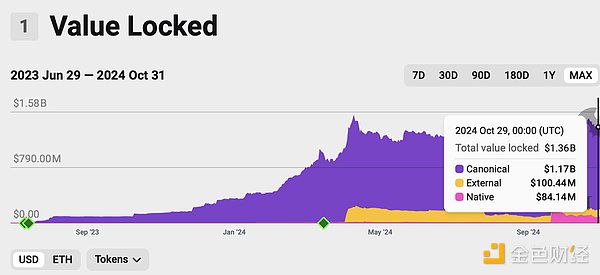
Mantle's TVL, source: l2beat, 2024/10/31
From the perspective of In-dApps TVL, the DeFiLlama data dashboard provides a more intuitive observation of its ecological composition. It is not difficult to find that the core sources are Dex, lending, Restaking and other DeFi fields, and the rapid growth of Dex TVL accounts for a relatively high proportion. This also shows that DeFi is Mantle's focus.
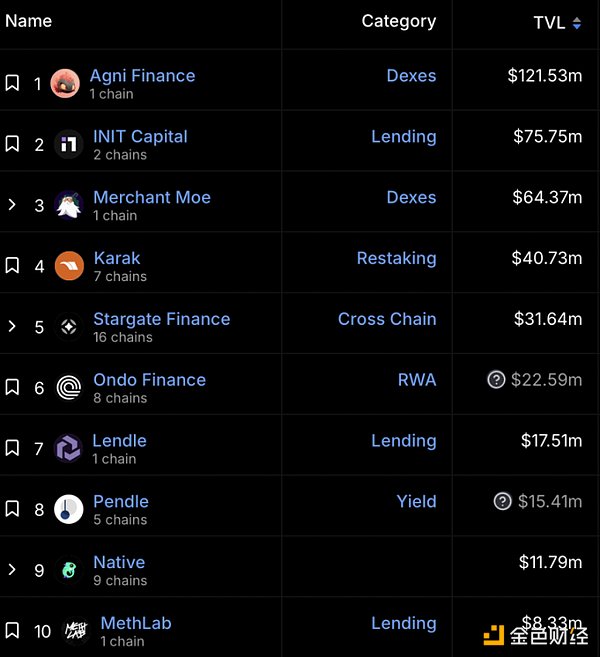
Mantle ecosystem project TVL, source: DeFillama, 2024/10/24
After looking at the TVL fundamentals, let's take a look at Mantle's on-chain activity. More and more L2s are born, just like a highway that has been built with a lot of time and energy, but there are very few cars on the highway because there is no demand. This is a common problem faced by most L2s: there are no high-quality applications. Therefore, it is more realistic to measure the prosperity of L2 through data such as user volume and transaction volume, and we have also seen the excellent user activity shown by Mantle's growth data.
In terms of the total number of users, Mantle had about 330,000 users in December 2023, and as of October 15, 2024, the total number of Mantle users has exceeded 4.42 million, a 13-fold increase in less than a year, indicating that more and more users are entering the Mantle ecosystem.

Mantle user data, source: Dune, 2024/10/24
In terms of daily active users, Mantle's monthly active users saw a significant increase at the end of April 2024, and maintained a higher average level thereafter. The current monthly active users are around 40,000, which is nearly 3 times the level around September 2023 more than a year ago.

Mantle's daily active data, source: Dune, 2024/10/24
In addition, in terms of transaction volume, as of October 23, 2024, the total transaction volume on the Mantle chain has exceeded 150 million, and the daily transaction peak has exceeded 2.2 million, showing strong on-chain activity. The more active the on-chain transactions, the higher the network transaction fee income, which to a large extent represents the network's stronger ability to self-generate blood.

Mantle's transaction data, source: Dune, 2024/10/24
Social media related data
As of October 24, 20234, Mantle has accumulated more than 800,000 followers on X, and the communities on Telegram and Discord are very active, with more than 200,000 members participating in discussions, AMA meetings and project updates. At present, Mantle's Discord community has attracted nearly 440,000 members, with more than 10,000 people online per day, becoming one of the most popular channels. At the same time, Twitter updates and interacts frequently.
In addition, Mantle has conducted more than 120 AMAs on official social media channels and ecosystem channels, hosted by KOLs and project team members. These include a series of events such as Mantle Ecowaves and Mantle Showcase Radio, which have played an important role in promoting user participation and adoption. In addition, Mantle can also be seen all over the world, and more than 50 offline events have been held so far.
1.4 Technical Architecture Principles
L2 Rollup is mainly divided into two types: OP (Optimistic Rollup) and ZK (Zero Knowledge Proof Rollup). Mantle Network implements L2 expansion solutions based on OP Rollup, and also develops its own DA layer of modular components.
Modular design significantly reduces transaction costs
When we discuss modular blockchains, we must first understand the concept of monolithic blockchains. Taking Ethereum as an example, a mature monolithic blockchain can generally be roughly divided into four architectures: execution layer, settlement layer, data availability layer/DA layer, and consensus layer. Each layer has its own unique functions and roles. In simple terms, Mantle's modular design is to handle the four key functions of the blockchain at different levels, rather than completing them on a single network layer like most single blockchains. The four functions are:
Transaction execution: It is carried out on Mantle's EVM-compatible execution settlement layer. Mantle's sorter generates blocks on the L2 execution layer and submits the state root data to the main blockchain.
Consensus and settlement: Responsible by the Ethereum L1 network.
Data availability: Based on Eigen DA, an independent data availability layer was developed, allowing Mantle to submit only the necessary state roots to the Ethereum mainnet for storing callback data that would normally be broadcast to L1.
Data acquisition: Other nodes obtain transaction data from Mantle DA through the DTL service, and verify and confirm it.
In the current blockchain architecture, OP Rollup needs to submit all transaction data to Ethereum's data availability layer at a high Calldata fee. As the transaction volume grows, this part of the fee is as high as 80-95% of the total fee, which seriously restricts the cost efficiency of Rollups. Mantle Network has successfully reduced operating costs through an independently developed modular data availability layer. In addition, the modular design makes it easier to access new technologies.
Decentralized sorter eliminates centralization risk
The sorter is the core role in the L2 solution responsible for collecting and sorting transactions, calculating status and generating blocks, and is critical to the security of the network. In traditional Rollup solutions, the sorter is usually a single centralized node, which is vulnerable to failure, manipulation or censorship. Mantle replaces the centralized sorter with a permissionless sorter cluster, bringing the following benefits:
Improves the availability of the network, eliminates the risk of single point failure, and ensures the continuous operation of the network.
Improves the consensus reliability of the network, prevents manipulation or censorship of the sorter, and ensures the fairness and transparency of transactions.
Improves the incentive compatibility of the network, drives the compliance behavior of the sorter through the reward mechanism, and ensures the long-term sustainability of the network. In contrast, centralized sorters face the public product dilemma.
1.5 Competitive Landscape
The era of Ethereum congestion has created the most grand narrative. In his article "The Three Transitions", V God proposed three major technical transitions that Ethereum needs to go through: transition to L2 expansion, everyone turns to Rollup; transition to wallet security, everyone uses smart contract wallets; transition to privacy, ensuring that privacy-protected fund transfers are feasible. V God believes that without the development of L2, Ethereum will fail due to high transaction costs.
It is in this context that the current L2 track is booming. According to L2Beat data, there are already 110 L2 or L3 expansion solutions running on the market, however, only a few L2s can gain mainstream recognition and generate a large number of TVL and users. As of October 24, 2024, the TVL of L2 scaling solutions has reached 37.62 billion US dollars, which has tripled compared to a year ago, showing strong development momentum and user demand.

Source: l2beat, 2024/10/25
Comparison between Mantle and mainstream L2
From the perspective of TVL, the top three are Arbitrum, Base and Optimism, and these top three L2s have occupied more than 73% of the market share. Mantle came from behind and became the fourth largest Layer2 one year after its launch.
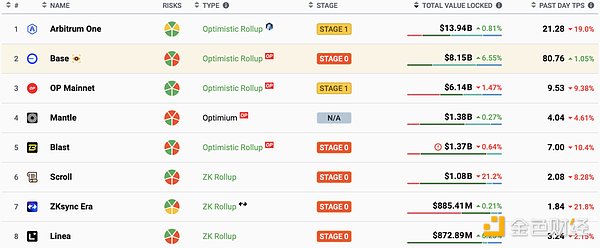
L2's TVL ranking, source: L2beat, 2024/10/31
From the perspective of FDV, Mantle is second only to Optimism and Arbitrum with $3.58 billion. From the perspective of MC/FDV, Mantle ranks first with 54.1%, which proves that MNT will face less selling pressure in the future.
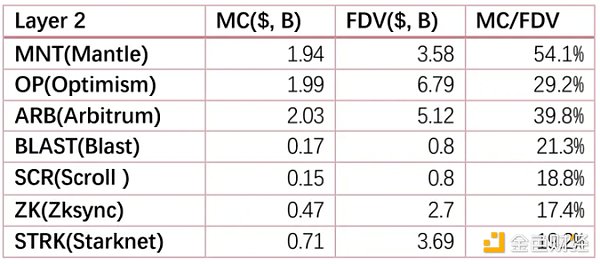
Source: Coinmarketcap, 2024/10/26, compiled by Klein Labs
In terms of revenue and profit, Base has surpassed Abitrum to become the most profitable L2 since March this year, and Mantle has remained in the top five.
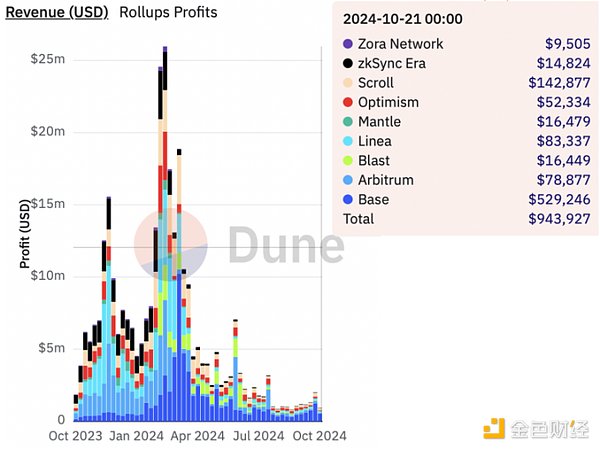
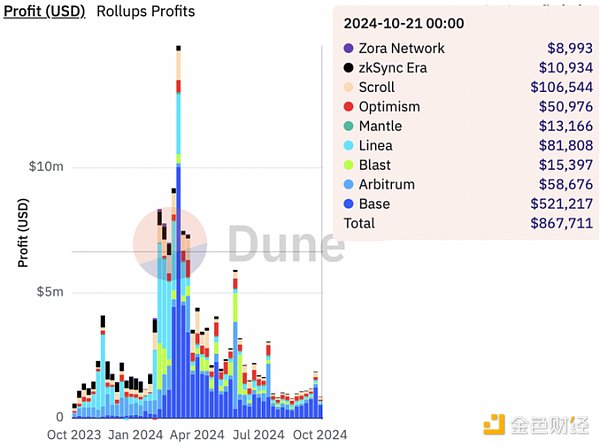
Source: Dune, 2024/10/26
Comparison of Mantle with public chains with trading backgrounds
Mantle's early supporters include the third largest exchange Bybit, which also brings it unique advantages. In this section, we will also look at some other L2s with exchange backgrounds for comparative analysis.
Speaking of the public chains supported by exchanges, we all know that Binance has incubated BNB and opBNB chains, Coinbase has incubated Base, and OKX has supported X Layer, etc. On October 24, the exchange Kraken also just announced plans to launch its L2 network Ink, which is expected to be launched on the mainnet in early 2025.
Before introducing these L2s, let's take a look at the major exchanges behind them. According to the ranking of Coinmarketcap, Binance, Coinbase and Bybit are the top three crypto exchanges, and OKX and Kraken are ranked 4th and 6th respectively. This also means that among the top 6 exchanges, 5 have supported at least one public chain. This is also an important strategic choice for exchanges.
The entry of exchanges into the public chain field is not only to expand the service boundaries, but also to explore the transfer from "off-chain" to "on-chain". This trend will guide a larger number of users and assets to gradually migrate from off-chain centralized exchanges (CEX) to on-chain (decentralized finance, DeFi) platforms, making the trading ecosystem move towards decentralization. Public chains and exchanges have something in common in essence. Both require new assets to be issued and traded on them to generate income. The rich asset operation experience and high-quality industry resources of exchanges are also one of the competitive advantages of this type of public chain.
1.5.2.1 BNB Chain
BNB Chain (formerly Binance Chain) was created in 2019. At that time, the utility token BNB, which was launched in 2017, was migrated from the Ethereum network to BNB Chain. BNB Chain was renamed from BSC. Although it is L1, we also briefly introduce it here due to its strong Binance background.
BNB Chain's current TVL has reached 4.7 billion US dollars. BNB Chain has successfully made DeFi a strong field with the exchange background and financial support of Binance, the most well-known of which is Pankecswap.
Binance's financial and technical support are undoubtedly important advantages of BNB Chain, but the close relationship with the exchange has also raised questions about the degree of decentralization. For example, in the hacker attack in 2022, in order to quickly control the situation, Binance requested all validators to suspend transactions on BNB Chain. This centralized operation actually reflects the limited number of verification nodes on the chain at the time, and also means that most nodes are directly or indirectly controlled by Binance.
How to reasonably utilize the resources of the exchange behind it while gradually achieving independent on-chain governance and truly practicing the decentralized Web3 concept is actually a key issue that all public chains incubated by exchanges will face.
In addition, BNB Chain also launched opBNB, an EVM-compatible L2 scalability solution based on OP Stack, in Q2 2023. According to DeFiLlama data, opBNB's current TVL is $21.6M and is still in its early stages of development.
1.5.2.2 Base
Base is an Ethereum L2 public chain incubated by Coinbase. Since Coinbase is subject to SEC supervision, it is difficult for Base itself to issue tokens, which means that it lacks a natural token economic incentive advantage compared to other L2s.
Despite this, Base has achieved remarkable success within a year of its launch, with its TVL experiencing two explosive growths in April and September of this year, and now exceeding US$2.4 billion. We have also seen innovations such as Friendtech on Base.
The top five projects contributing to Base's TVL are all from the DeFi field. It is worth noting that Aerodrome Finance, which ranks first, contributed nearly 54% of Base's TVL with US$1.3 billion. Aerodrome was launched on Base on August 28, 2023, and is a DEX based on an automated market maker (AMM).
1.5.2.3 Cronos zkEVM
Cronos is a blockchain launched by the cryptocurrency exchange Crypto.com (ranked 13) in November 2021. It is an Ethereum-compatible L1 network, but its TVL has not been significantly improved since its launch. Subsequently, Cronos' development team Cronos Labs and Matter Labs further launched the zk-based L2 network Cronos zkEVM, which was just launched on the mainnet in August this year.
Cronos zkEVM's current TVL is stable at around US$17 million, and its current size is relatively small compared to the previous major chains.
1.5.2.4 X Layer
X Layer is a zk rollup-based L2 jointly launched by OKX and Polygon Labs in April this year. X Layer uses OKB as its native token, which can be used as gas fee payment. In subsequent planning, X Layer will continue a series of technical architecture optimization and scalability improvements, such as decentralization of the sorter. The current TVL of X Layer is 9.3 million US dollars.
From the perspective of TVL comparison, Base is relatively leading, Mantle ranks second, and Cronos zkEVM and X Layer are still at a relatively small scale.

Source: DeFiLlama, 2024/10/26
1.6 Preliminary Value Assessment
By comparing with different Layer 2 networks, we can intuitively judge the ecological prosperity and valuation level of the network, so as to better evaluate the development potential of Layer 2.
Before making a comparison, we need to note that unlike other L2s that use ETH as a Gas token, the MNT token is used as a Gas token for the Mantle chain. This needs to be taken into consideration when comparing with other L2 networks. We mainly calculated the following indicators:
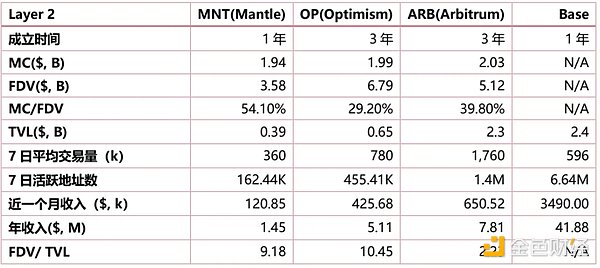
Data comparison, source: Dune, DeFiLlama, Klein Labs, 2024/10/26
It can be seen that compared with the Layer 2 networks of other OP Rollup tracks, Mantle's ecosystem is still in its early stages. However, Mantle's native token MNT has more than 50% in circulation, which makes its future selling pressure smaller than other public chains. In addition, Mantle has reached such a high level in hard-core data indicators such as TVL and on-chain revenue in such a short period of time. We have reason to believe that as the Mantle ecosystem continues to improve and prosper, its competitive position in the L2 track will continue to rise and reach a new height.
2. Mantle's Ecosystem
As Vitalik said, the ecosystem of the public chain is its killer feature. A rich and diverse ecosystem can not only attract more new users to enter, but also motivate existing users to interact more frequently and diversely in the ecosystem. Thinking about Mantle's growth from this perspective, although the rotation of the market cycle has indeed brought it a positive impact, what is more important is the help brought by Mantle's constantly enriching ecological landscape.
According to the latest data, there are 240+ dApps in the Mantle ecosystem, including 89 DeFi, 96 infrastructure, and 20 GameFi. DeFi and infrastructure occupy half of the country, which also reflects the prosperity of DeFi on Mantle as the infrastructure of the public chain.
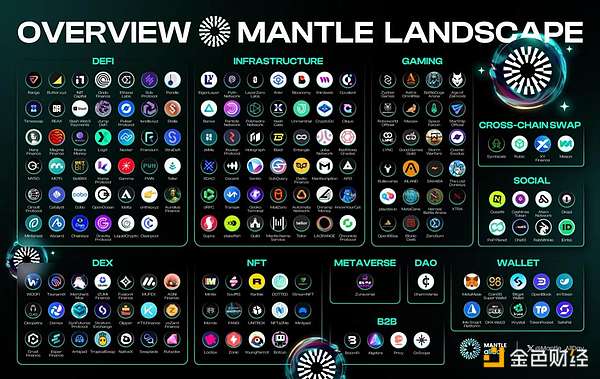
Source: Mantle, 2024/10/24
Below we will also analyze some projects in its ecosystem from these main categories:
2.1 DeFi track
DeFi is the basic disk of a public chain. The perfection of DeFi infrastructure largely affects the potential and upper limit of the development of the entire ecosystem. Among Mantle's DeFi projects, 36 are DEX, and the rest include lending, re-staking, etc. Below we will introduce some of these projects:
2.1.1 Agni Finance
Project Introduction: Agni Finance was founded in 2023 and is Mantle's native AMM-based DEX. It is also the number one project on Mantle in TVL ($121 million), with a total trading volume of $3.92 billion. Agni currently provides 6 currencies and 20 trading pairing services, and its most active trading pairing is METH/WETH. According to CoinGecko data, Agni's latest 24-hour trading volume is $4.36M.
After a doubling in July this year, Agni Finance's TVL has remained stable at a level of more than $100 million, doubling from Q2.
X: @Agnidex
2.1.2 INIT Capital
Project Introduction: Founded in 2023, INIT Capital is a platform for dApp and user interaction, providing both permissionless access to a unified liquidity pool and efficient yield management. As a built DeFi liquidity infrastructure, INIT provides a variety of activities, including lending and yield strategies. Init is now available on Mantle & Blast. As of writing, INIT Capital has a market size of $110 million and a total loan amount of over $24 million.
INIT Capital announced the completion of a $3.1 million seed round of financing at the end of February 2024, led by Electric Capital and Mirana Ventures.
X: @InitCapital_
2.1.3 Merchant Moe
Project Introduction: Merchant Moe is a DEX founded in 2024. It is a product of Trader Joe and is designed and built to serve the Mantle ecosystem and community. It will be launched on the mainnet in January 2024, and the $MOE token will also be officially launched. Currently, trading services for 14 currencies and 22 trading pairs are available, and the most active trading pair is METH/USDT.
According to MIP-28, Merchant Moe will receive liquidity support from Mantle Treasury. In addition, Merchant Moe has also received seed investment from Mantle EcoFund.
X: @MerchantMoe_xyz
2.1.4 Ondo Finance
Project Introduction: Ondo Finance is a financial protocol focused on the RWA track. At present, its main business is to tokenize high-quality assets such as US Treasury bonds and money market funds within a compliance framework for users to invest and trade on the blockchain. The RWA US Treasury track where Ondo is located has seen a 6-fold increase in TVL in the past year, making it the main driving force of the RWA industry. Ondo Finance's TVL has grown rapidly since April and currently ranks third in TVL in the RWA track. It has a certain first-mover advantage and is expected to develop in the future. Ondo Finance currently supports 8 chains, of which the TVL on Mantle ranks third, surpassing Aptos, Arbitrum and Sui.
X: @OndoFinance
2.2 Wrapped assets
To be precise, Wrapped Assets belongs to the category of DeFi, but in view of Mantle's remarkable achievements in this field and its recent continuous efforts and attention, we will analyze this sector separately.
On October 23, Bybit launched cmETH and planned to launch COOK, the governance token of mETH, which quickly detonated the entire network. Before interpreting cmETH and COOK in detail, we need to understand what mETH is.
2.2.1 mETH
mETH is a permissionless, non-custodial ETH liquidity staking protocol, where users can obtain mETH (1:1) by staking ETH. Currently, mETH has 15,025 validator nodes and more than 480,000 ETH are staked.
As the native LSD protocol launched by Mantle, mETH has achieved rapid growth since its launch on December 4, 2023. In less than a year, its TVL reached $1.22 billion, and it is currently the fourth largest Ethereum LSD product.
Looking back at the background of the birth of mETH, in June 2023, Ethereum had successfully transitioned from PoW to Proof of Stake PoS, and Lido Finance had already firmly established its market leadership with a TVL of $13 billion. Competitive products such as Rocket Pool (rETH) that followed closely behind made the competition in the liquidity staking (LSD) track extremely fierce. For mETH, which just had its first round of discussions on the Mantle Governance Forum, it obviously did not gain a first-mover advantage.
However, after sufficient community governance discussions and technical preparations, on December 8, 2023, the ETH liquidity pledge protocol for all users was officially launched (at the time, Mantle LSP). With its strong performance, mETH quickly emerged in the fierce LSD track and became a "new player" at the time.
According to DeFiLlama data, within a week of its launch, the TVL of Mantle LSP exceeded US$100 million, and then climbed all the way to a peak of nearly US$2.2 billion in March this year. Currently, TVL is stable at more than US$1.2 billion, making it the fourth largest LSD product on Ethereum. In addition, official data show that mETH has more than 8,000 wallet users on Ethereum and 26,000 wallet users on the Mantle network, and the number of users and activity are also eye-catching.
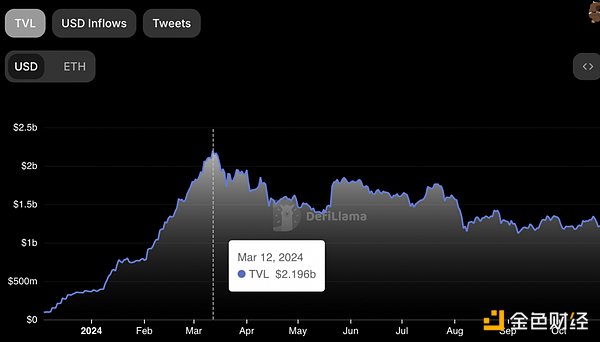
Source: DeFiLLama, 2024/10/25
mETH holders can access various DeFi platforms for liquidity pools, yield farming, and other financial activities without unstacking ETH. Here are a few examples of dApps available to users:
For trading, Bybit offers mETH/USDT and mETH/ETH pairs, while NativeX offers mETH/WETH pairs and other exchange options.
In terms of lending, INIT Capital allows deposits/borrowing positions with ETH, Timeswap uses ETH as collateral, and MYSO Finance offers zero-fee swaps and customized zero-liquidation loans.
In terms of liquidity, Merchant Moe offers a variety of liquidity pools, while Butter.xyz allows liquidity to be added to any available token, including ETH and MNT.
This is also the unique advantage of mETH: backed by Mantle's rich and mature ecological landscape, mETH is given more liquidity scenarios, bringing richer profit space and stronger demand for mETH. This healthy and virtuous development model further promotes the continued growth and prosperity of mETH.
2.2.2 cmETH
At the end of May 2024, half a year after the official release of mETH, the MIP-30 governance proposal was passed, and cmETH was launched as a new liquid re-staking token (LRT). Specifically: mETH is used as a liquidity staking token, and users stake ETH to obtain mETH; and cmETH is used as a liquidity re-staking token, and users can stake mETH again and obtain cmETH at a 1:1 ratio.
Like mETH, cmETH will be highly composable in the Mantle ecosystem (including EigenLayer, Symbiotic, Karak, Zircuit, etc.), allowing users to explore more revenue opportunities through L2 and decentralized applications and protocols while maintaining the advantages of mETH. Compared with mETH, the core advantage of cmETH is that in addition to the basic staking income, it also covers more income opportunities, including the points income of major re-staking (airdrop expectations), re-staking AVS income, etc.
In short, cmETH is a higher risk-return option than mETH, and is more suitable for those users who want to try to obtain higher returns within a certain risk range. In addition, while the MIP-30 governance proposal launched cmETH, it also foreshadowed the issuance of $COOK as the governance token of mETH.
Here we mention Mantle's massive first season Methamorphosis event starting in July 2024: In this 100-day event, mETH once again played its ecological advantages and directly announced 23 partners, including EigenLayer, Symbiotic, Karak, Zircuit, Pendle and other well-known projects. Users holding mETH can participate in interactions and complete tasks to receive rewards, and Power can be exchanged for COOK tokens in the future.
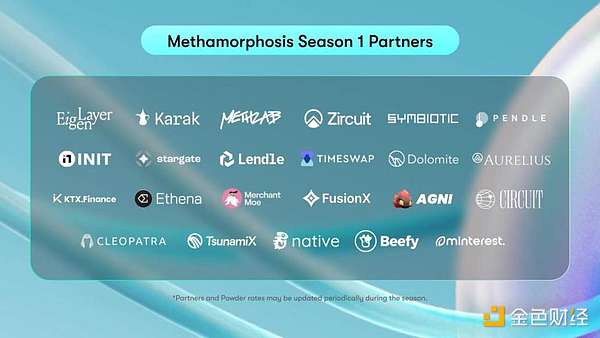
Source: Mantle
Although the first season has ended, on October 23, mETH announced that the second season of Methamorphosis is about to begin. There is no doubt that the Mantle ecosystem will usher in another wave of hot growth.
2.2.3 FBTC
Mantle's Wrapped Assets are not limited to ETH. In its ecosystem, FBTC, jointly launched with Antalpha and others, represents another important form of liquid assets. Introducing BTC into the Ethereum ecosystem, WBTC has been relatively successful before, but it sometimes falls into a crisis of trust. At this time, FBTC will be a better choice.
FBTC is a full-chain Bitcoin asset that is pegged to BTC at a 1:1 ratio and provides cross-chain bridging and trading functions on the Ethereum and Mantle networks, thereby improving the accessibility and practicality of Bitcoin. By introducing FBTC, Mantle not only enriches the types of on-chain liquid assets, but also creates new options for cross-chain transactions for users, optimizing the overall user experience.
FBTC and mETH and other products together constitute Mantle's multi-dimensional layout in the field of liquidity and cross-chain, helping to build its on-chain DeFi income ecosystem. Thanks to the support of the Mantle ecosystem, this multi-chain asset layout will drive it to become a strong competitor in the field of Layer 2 and cross-chain liquidity.
2.3 Game
Grant Zhang is the head of the Mantle ecosystem game sector. Zhang has a rich resume in the game industry. He has led the distribution team of games such as "League of Legends" and "Game of Thrones". The game projects he participated in have been downloaded more than 500 million times.
In the layout of the game sector, Mantle's strategy is very different from most other ecosystems. This difference is mainly reflected in Mantle's team. In other ecosystems, the development of the game sector is usually led by excellent investors, while Mantle's game team is more composed of distribution and operation experts in the game industry. Therefore, Mantle is able to provide more substantial support to its game partners, including tokenization design, economic model, game distribution, financing and user acquisition.
In addition, although Mantle has the largest treasury in the Web3 field, it is still very cautious in choosing supported games. Unlike other ecosystems that may try to introduce hundreds of games to the ecosystem by "casting a wide net", the Mantle ecosystem actually only selects about 7-8 games to establish in-depth cooperation and provide real support. Because of this, the funding and support that these selected games can get are much more substantial.
Here are some core game projects for introduction:
2.2.1 Catizen
Catizen is a cat-themed game mini applet built on the Telegram applet. Players feed cats and get rewards by sliding. According to a tweet posted by Telegram CEO Pavel Durov, as of July 30, 2024, Catizen has more than 26 million players, which is just over 4 months from its launch on March 19, 2024.
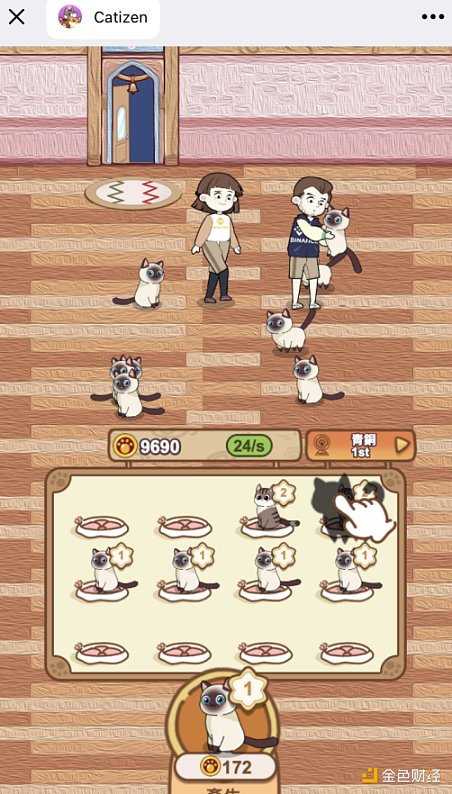
Catizen example, source: Catizen
In April 2024, Catizen established a strategic partnership with Mantle. But in fact, Mantle's partnership with Catizen and its publisher Pluto Studio dates back to August 2023. Whether it is game design, token economics or user acquisition, or even cooperation with TON, Mantle provides full support. The reason why Catizen chose Mantle to cooperate is as mentioned above. Mantle's unique team structure can provide professional and practical support for game projects. These supports can strongly promote the success of the project, which is also something that other ecosystems cannot do.
For Mantle, hyper-casual games like Catizen and Tap to Earn are just the beginning. These games are perfect for attracting users and bringing the massive Telegram user base into mini-games. In the future, Mantle plans to grow with the Telegram mini-game ecosystem and continue to release more suitable game products at each stage of evolution.
As of press time, Catizen has more than 600,000 users on the Mantle blockchain. CATI tops Mantle's Natively Minted Value list with $76.63 million.
X: @CatizenAI
2.2.2 MetaCene
MetaCene is a massive multiplayer online role-playing game (MMORPG) that incorporates Web3 elements. It combines NFT, blockchain mechanisms and AI technology with classic game mechanisms such as PvP battles and land management. MetaCene was founded by Qunzhao (Alan) Tan, an experienced game company developer.
As a large-scale MMORPG game, MetaCene has more complex requirements in terms of cost, rules and economic model design. And Mantle has teams such as Game7, Hyperplay, Yeeha and Community Gaming, which can provide comprehensive support in terms of user acquisition, engagement, wallet infrastructure, entry, security, etc., and can provide more practical support for MetaCene.
It is worth mentioning that the founder of the professional blockchain game guild No. 1 Alliance said after an in-depth experience of Metacene that MetaCene's game depth design is reasonable and the player composition is international, which also indirectly proves the playability of the game.
As of press time, there are more than 510,000 users on Metacene, and the number of daily active users once exceeded 360,000.
X: @MetaCeneGame
2.2.3 Funton.ai
Funton.ai is a new member of the Mantle ecosystem in October this year. As the leading modular multi-game platform in the TON ecosystem, Funton.ai is committed to building a decentralized GameFi ecosystem that combines artificial intelligence and games, and provides one-click game generation services. As of July this year, its monthly active users have exceeded 350,000. The cooperation with Mantle will help attract hundreds of millions of Telegram users into the Mantle ecosystem. Funton.ai also customized Flappy MNT for Mantle. Connect a wallet containing $MNT to earn $MNT + FUN Points by playing games.
It is worth mentioning that Funton.ai has recently cooperated with multiple organizations such as Gate Exchange and OKX Wallet to carry out airdrop activities for its token $FUN, which further expanded its influence and user base in the market. At the same time, Funton.ai also entered the acceleration camp of Web3Labs and KuCoin Labs, and further gained recognition from mainstream Web3 institutions.
X: @funton_ai
3.4 Other Ecosystem Related
Mantle has always invested a lot of energy in the development of ecological support, and is also a role model for various public chains. The following is some information related to ecological support and activities:
2.4.1 EcoFund
Mantle EcoFund is an ecological fund of up to US$200 million provided by Mantle Treasury, which aims to promote the adoption of developers and dApps on the Mantle network, give priority to investing in teams that build high-quality and innovative projects within the Mantle ecosystem, and increase investment in potential excellent projects when appropriate.
According to the official website, EcoFund has funded more than 13 projects, among which INIT Capital, Catizen, Merchant Moe and other projects have grown into the backbone of the Mantle ecosystem.
2.4.2 Mantle Grants
To further promote ecosystem vitality, Mantle has created two incentive programs:
Mantle Scouts Program. Launched in April 2024, it authorizes 16 industry leaders to issue $1 million in MNT token grants to high-quality projects within the ecosystem to support innovative projects. The program provides mentor guidance, network resources, and financial support to accelerate the success of projects in the Mantle ecosystem.
Public Grants. Mantle provides grants (up to $20,000 in MNT) to early-stage projects to cultivate a vibrant developer community.
2.4.3 Game 7
As Mantle focuses on the development of the ecosystem, Mantle has also launched a game accelerator program in cooperation with Game7. Based on the Mantle Network infrastructure, Game7 provides key tools for game developers, such as NFT markets, cross-chain bridges, game DAOs, etc., to provide high-quality user experience and ecological interconnection for its incubated and invested game projects. The two will be committed to promoting the development of a permissionless and interoperable game world.
2.4.4 Sozu Haus
In terms of developer activities, Mantle has sponsored and hosted 26 hackathons worldwide, as well as numerous technical seminars and online AMA meetings. More than 900 hackathon projects were submitted. Mantle also organized six exclusive Sozu Haus events (Mantle's mini accelerator and maker home program), and held large-scale global crypto events to attract top founders and developers.
2.4.5 Other Ecological Partners
In addition to its own huge ecosystem, Mantle is also actively working with other partners in the industry. These partners not only support the expansion of the Mantle ecosystem, but also provide it with technical and liquidity resources in the fields of capital support, user traffic, development resources, market trust and industry endorsement, and developer education.
For example, Mirana Ventures continues to provide financial and resource support for the Mantle ecosystem. Mirana Ventures was also shortlisted for the Top100 investment institutions in 2023 selected by RootDada. Its fund has a management scale of tens of millions of US dollars and has established and incubated multiple projects. The representative investment projects include: TON, Morpho, Zircuit, Story Protocol, etc. In addition, Mantle is also the only technical partner of Eigenlayer.
In terms of the developer community, Moledao is also an ecological supporter of Mantle. Moledao is committed to providing resource docking and support for early Web3 projects and developers. Through the Web3 series of public welfare courses, hackathons and other offline activities, Moledao helped Mantle contact and attract many outstanding blockchain projects and developers. As a developer community, Moledao continues to provide Mantle with technical innovation support and talent reserves to help it quickly build and improve the blockchain ecosystem.
2.4.6 Ecological Incentives
Mantle's huge treasury (nearly US$3 billion, the second largest in the world) is Mantle's biggest source of confidence. The PoS interest income of the Treasury can be directly fed back to users, for example, the restaking income of EigenLayer can be used as an ecological reward. This reward mechanism has really increased the motivation of users to participate in the ecosystem. Through ecological interaction or staking, users can not only support the development of the ecosystem, but also get a share of the Treasury income, making the entire ecosystem more dynamic.
3. Summary of highlights
In the past year or so, Mantle has demonstrated its strong competitiveness in the L2 track through impressive growth data. For users at this stage, with the in-depth integration of the ecosystem and the arrival of cmETH and COOK, Mantle will continue to grow strongly in the future. In the face of this foreseeable growth, we have the following main views:
Bybit's strong endorsement: Based on the close relationship between Mantle and Bybit, excellent projects in the Mantle ecosystem will have the opportunity to be listed on Bybit and be discovered by more investors through Bybit's recommendation. For dApps development teams, this is an extremely attractive resource and exposure channel.
The world's largest treasury support: The Mantle Treasury of nearly $3 billion is a strong backing for projects built on the Mantle Network and the biggest source of confidence for its ecological development. Mantle is building a more rewarding financial and consumer on-chain application center. For example, the interest income generated by the treasury can create additional subsidies to be fed back to users.
Advantages of technical architecture: Mantle's modular design provides significant scalability and cost optimization advantages, and also makes Mantle more flexible and able to innovate openly.
Fourth largest Ethereum LSD product: Mantle's top four TVL contributions all come from the DeFi field. It is crucial to achieve the ideal liquidity integration of DeFi. The Mantle ecosystem is committed to solving the problem of liquidity fragmentation and placing a heavy bet in the field of liquidity staking. Relying on advanced underlying design and powerful ecological empowerment, mETH has grown into the fourth largest Ethereum LSD product in a short period of time.
Throughout the game ecosystem: So far, the game sector in the Mantle ecosystem has launched 7 flagship products, among which projects such as Catizen and MetaCene have performed outstandingly in their respective segments. Mantle plans to gradually release all game products in the next few quarters to promote further growth of the ecosystem.
Fully support developers and founders: The Web3 industry needs more innovation and crypto application cases. Mantle has implemented a variety of developer incentive programs, such as Sozu Haus's Hacker Home Program, and provided a $200 million EcoFund to actively tap and support top developer talents. For talented, creative and passionate developers, Mantle is an ideal growth platform.
As a Layer 2 project that is both cost-effective and in line with future trends, Mantle has the potential to lead the development of on-chain transactions and applications, providing an ideal ecological environment for DeFi and decentralized applications. We should not only pay attention to Mantle's potential as a Layer2, but also compare Mantle with the entire public chain track. Its performance, ecology, TVL, etc. have surpassed most Layer1s. Considering its relatively short growth history, strong financial support from the treasury, and its good performance in "doing the right thing", we have every reason to expect that Mantle will bring surprises to the web3 world.
Perhaps the next paradigm-level innovation will happen in Mantle?
 Catherine
Catherine























